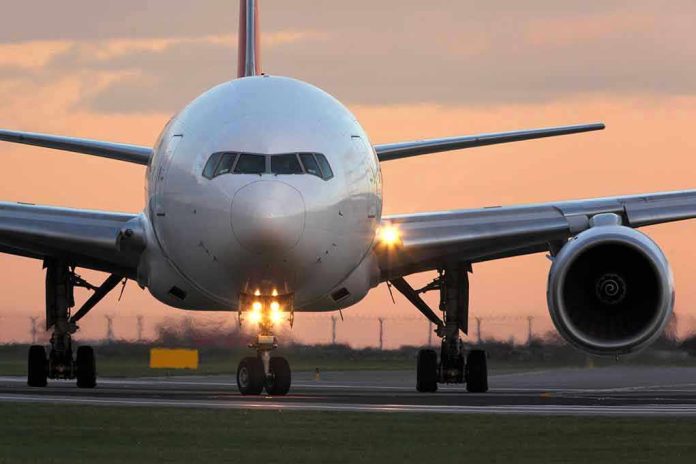
When a routine transatlantic flight turns into a chaotic scene of violence, it challenges the very fabric of aviation security.
Story Snapshot
- A Lufthansa flight from Chicago to Frankfurt was diverted due to a midair stabbing incident.
- The attacker, an Indian national on a student visa, allegedly used a metal fork as a weapon.
- The victims were two teenagers, raising concerns about passenger safety and airline protocols.
- The incident occurred during a U.S. government shutdown, possibly affecting emergency response.
Midair Crisis: From Fork to Weapon
A Lufthansa flight from Chicago to Frankfurt faced an unexpected turn when a 28-year-old passenger allegedly attacked two teenagers with a metal fork. The attack took place during meal service, a time when passengers are typically relaxed, highlighting a gaping vulnerability in in-flight safety protocols. The flight diverted to Boston Logan International Airport where the suspect was apprehended, leaving passengers and authorities grappling with the implications of such an incident.
The suspect, Praneeth Kumar Usiripalli, was reportedly on a student visa studying biblical studies but had lost his lawful immigration status. His motivations remain unclear, but the attack underscores the precarious nature of security at 35,000 feet. With over 300 passengers on board, the potential for disaster was immense, yet the flight crew managed the situation, averting further harm.
Security Under Scrutiny
The use of a common metal fork as a weapon raises questions about the current practices of in-flight dining services. Airlines may need to reconsider the materials used for utensils or enhance screening processes to identify potential threats among passengers. This incident also puts a spotlight on the limitations of current behavioral screening methods, which failed to predict such a violent outburst from a seemingly ordinary traveler.
The broader context of a U.S. government shutdown adds an additional layer of complexity. With federal aviation operations potentially affected, the coordination of emergency responses could have been compromised. The incident serves as a wake-up call, urging authorities to reassess both the tangible and procedural aspects of aviation safety.
Legal and Immigration Dimensions
Usiripalli now faces federal charges of assault with a dangerous weapon, a serious offense under aviation criminal statutes. If convicted, he could face up to 10 years in prison and substantial fines. This legal pursuit underscores the severity with which such onboard crimes are treated, reflecting a zero-tolerance policy towards violence in the skies.
His immigration status also presents a conundrum. As someone who overstayed or violated visa terms, his case highlights potential gaps in immigration enforcement. The involvement of Immigration and Customs Enforcement (ICE) could lead to deportation proceedings, further complicating the legal landscape.
Industry Implications and Future Outlook
The repercussions of this incident are likely to reverberate throughout the aviation industry. Airlines might face increased scrutiny over their in-flight safety protocols and utensil policies. There could be a push for more comprehensive passenger screening technologies, aiming to identify behavioral risks before boarding.
Moreover, the incident may affect passenger confidence, particularly on international routes. Families and individuals may reconsider the safety of air travel, demanding more transparency and assurance from airlines. For Lufthansa, managing the reputational impact and addressing operational liabilities will be critical in maintaining trust.



